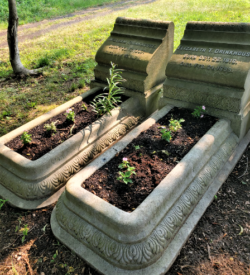Title: Tin plate business owner
Birthdate: February 13, 1807
Death Date: May 10, 1879
Plot Location: Section 43, Lot 103

It’s not often that a couple would have nine children and eight of them be boys. A mathematician would call it “statistically improbable,” but Bill Drinkhouse grew up in such a family. His own marriage produced ten children but with the perfectly balanced ratio of five boys and five girls.
His grandfather carried the original family name of Trinckhauss with him from Germany when he arrived in Philadelphia in 1751. When he settled in Reading he shortened his name from Johann Adam to just Adam and anglicized his last name to Drinkhaus. Bill’s father went a step further so his nine children would have the name Drinkhouse. All of them grew up in Reading or near there in Berks County.
Three of the eight boys ventured away from rural life to seek their fortune in Philadelphia. In 1836 Bill married a Philly girl who, coincidentally, shared her name with a famous movie star of the 20th century, Elizabeth Taylor Warner. Bill made his living in the city as a tin plate maker (tinsmith) and did very well. Metal workers were skilled craftsmen before the Industrial Revolution mechanized many jobs.
By 1850 the household included his wife, six children, and two Irish servants. The 1860 census showed that the family had ten children but got by with one less servant.
He was apparently the owner of his own successful business, borne out by the value of his personal estate. It was listed as $2000 in 1860, reaching $120,000 by 1870. After the war they moved to 607 North 10th Street, just north of Vine and east of Broad, where several neighbors enjoyed similar wealth. In the 1878 city directory his occupation was listed as “president.” Unfortunately the name of his  business remains a mystery.
business remains a mystery.
This newspaper story sheds some light on Bill’s standing in his profession. He may have been involved in manufacturing kettles, jugs, and cooking utensils, or other metal products since his occupation listed in 1870 was “retired merchant.” Or he may have owned a metal roofing company, since his two oldest sons were both in that line of work. Perhaps they worked for him.
Bill died in1879 of what his doctor called Adynamia, which means lack of strength or vigor due to some underlying disease or medical condition. He and Elizabeth, who died 20 years later, were each buried in what is known as a cradle grave. It was a popular choice in the Victorian era, especially with people of German descent who brought the custom with them. There was a headstone, a footstone, and two low stone walls connecting them, designed to hold plants or flowers. Four of their children are in the same plot.
He specified in his will that $300 should be set aside, the income from which to be applied “to the keeping of the said burial lot in good order in all the years to come.” Bill assigned various percentages of his investment portfolio among his heirs. Elizabeth received  34 percent and the remaining children and grandchildren were given between 7-9 percent. This news clipping reveals the final appraisal of his estate which, in today’s dollars, would make him a multi-millionaire.
34 percent and the remaining children and grandchildren were given between 7-9 percent. This news clipping reveals the final appraisal of his estate which, in today’s dollars, would make him a multi-millionaire.

Support the Friends of Mount Moriah
Help us in our mission to restore and maintain the beautiful Mount Moriah Cemetery by donating to our cause or volunteering at one of our clean-up events.

